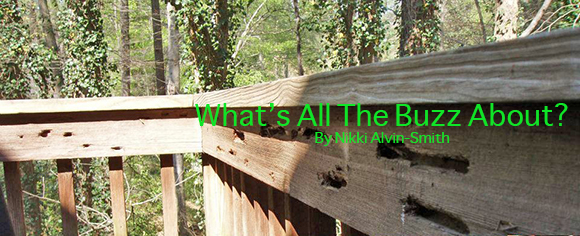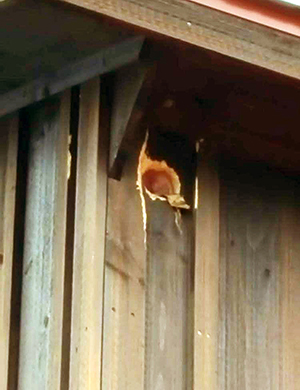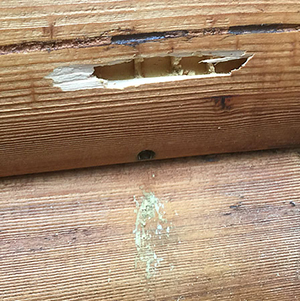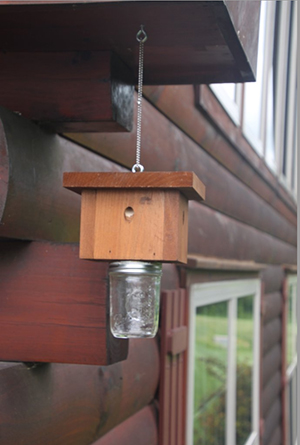What’s All The Buzz About?
By Nikki Alvin-Smith

Your beautiful new barn, indoor or log home is a joy to behold. Great care and craftsmanship has gone into its construction and you delight in its daily use and benefits.
One day as you sit on the front porch, or garden bench in front of the barn, you hear the distinctive loud buzz of the Carpenter Bee. You notice right away that it is much larger than the most useful Honey Bee, and it is strangely attracted to the top of your building out of reach.
 ‘What is it doing up there’, you wonder, with its continual buzzing.
‘What is it doing up there’, you wonder, with its continual buzzing.
Before long a few more bee brethren have joined it. The bees continue to engage in their noisy activity and then they disappear from view. However, you discover that there are large holes that have appeared in the siding of your structure. Yes, these pesky bees have drilled large holes into your building and have taken up residence inside to lay their eggs. In fact, there is a neat line of holes across a wide span of your structure within a few weeks. Humm. What should you do about that? You might think nothing or you may try to reach them with a chemical spray to kill them. The spray falls mostly on you and seems to do little and perhaps you worry about the spray poisoning the horses that graze beside that wall. Chemical treatments are expensive, and often smell awful and are harmful to breathe. 
The advent of the Carpenter Bee is a harbinger for the arrival of another visitor. The woodpecker. Yes, the woodpecker does of course ‘peck wood’. And the woodpecker quickly ascertains that the drilled holes that have been carefully orchestrated as nests for laying the Carpenter Bee’s eggs, are ripe for the pecking!
“Peck. Peck,” goes the woodpecker, as he destroys the wood that surrounds the drilled holes in his attempt to garner his feast of bee eggs. Before long, the entire length of the siding or beam or rafter, has been decimated.
There is a simple, economic and eco-friendly solution to this problem. Say hello to The Amish Bee Trap.
Amish Bee Traps are an inexpensive yet effective protection for your building. Their clever design will prevent damage from Carpenter Bees. How do they work?
The Amish Bee Trap mimics a standard nest.
 The soft composite plywood traps, attract the lazy Carpenter Bee with their specific sized diameter holes drilled into the wooden base (which are angled upward as this shuts off the light source once the bee is inside the trap) and offer an invitation to the bee to come inside and take up residence. No effort required. Come on in and enjoy a warm Amish Bee Trap welcome. Honey Bees are not attracted to the trap as the holes are a specific size that only the Carpenter Bee will use.
The soft composite plywood traps, attract the lazy Carpenter Bee with their specific sized diameter holes drilled into the wooden base (which are angled upward as this shuts off the light source once the bee is inside the trap) and offer an invitation to the bee to come inside and take up residence. No effort required. Come on in and enjoy a warm Amish Bee Trap welcome. Honey Bees are not attracted to the trap as the holes are a specific size that only the Carpenter Bee will use.
Once inside the bee trap the Carpenter Bee realizes this is not the best residence for its nesting activity and tries to leave. Naturally, it heads for the light, which the Amish Bee Trap happily provides via the bottle at the bottom of the trap.
The Amish Bee Trap has now successfully set up the bee’s demise, as the bee cannot escape. This rogue, the Carpenter Bee, cannot fly upwards or return to the box of the trap. As an added bonus the death of the bee results in a pheromone release which attracts other Carpenter Bees to the trap. They just can’t help themselves. Nature at its finest!
Eco-friendly Amish Bee Traps not only work brilliantly but they require no chemicals or bait.
So say goodbye to the pesky Carpenter Bee with this simple trap. You can purchase it online at www.AmishBeeTraps.com and it makes a great gift that solves a big problem.


